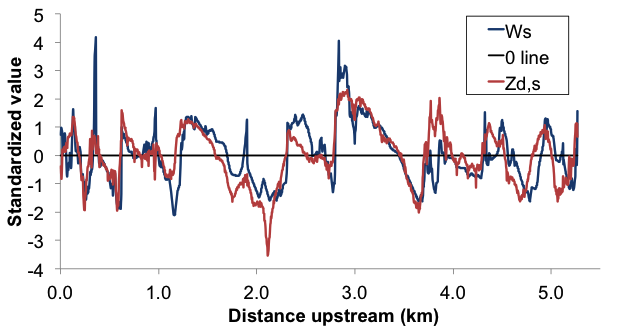Geomorphic Covariance Structures
Participants
Gregory B. Pasternack, Dr. Rocko Brown, Dastagir Baig, Joni Gore, Matthew Weber, Anne Senter
Background
River scientists have long known that natural rivers are highly heterogeneous in their spatial structure and physical-biological linkages, but most analyses have taken a blind statistical approach to the problem, and this cannot explain the coherent organization to heterogeneity. Certainly, using statistics to blindly explore and affirm that heterogeneity exists was important, but now we need to know exactly what those patterns are, why, and how they function. This cannot be achieved with exploratory statistics. Instead, analyses must show how variables relate to each other. Toward this end, we have invented the concept of a "geomorphic covariance structure".
Geomorphic Covariance Structures
Many measurable variables in geomorphology and allied sciences vary along a pathway, such as a river corridor. Variables could be flow-independent measures of topography, sediment attributes, flow-dependent hydraulics, topographic change, and biotic variables. Rocko Brown coined the term "geomorphic covariance structure" (GCS) to mean the bivariate pattern of any two such variables. It is not the statistical covariance, which is a single number, but instead a new concept involving the complete bivariate spatial series form which a statistical covariance could be computed if desired. This project investigates the coherent patterns of all conceivable GCSs, beginning with those of physical variables in river corridors and moving on from there.
River Bed Elevation and Width GCS
The first GCS that we have looked into in great detail is that between river bed elevation and channel width. Many theories of how rivers function and practices for how rivers should be engineered for various purposes specific an explicit GCS between bed elevation and width. Some require them to be "in phase" (i.e., high width and high bed elevation or the converse), while others require them to be "out of phase" (i.e., high width and low elevation). We have conducted several studies that analyze these patterns in real rivers and in natural channel designs.

Links
None.
Publications
- Brown, R. A., Pasternack, G. B. 2014. Hydrologic and topographic variability modulate channel change in mountain rivers. Journal of Hydrology 510: 551-564.
- Brown, R. A., Pasternack, G. B., Lin, T. 2015. The topographic design of river channels for form-process linkages for river restoration. Environmental Management, 57 (4): 929-942. doi: 10.1007/s00267-015-0648-0.
- Baig, D., Pasternack, G. B., Weber, M. D. 2016. The role of river corridor topographic variability in controlling hydraulic conveyance and geomorphic process as a function of discharge. American Association of Geographers Annual Meeting, San Francisco, Calif., 27 Mar to 2 Apr.
- Gore, J., Pasternack, G. B. 2016. Analysis and classification of topographic flow steering and inferred geomorphic processes as a function of discharge in a mountain river. Abstract EP53D-1016 presented at 2016 Fall Meeting, AGU, San Francisco, Calif., 12-16 Dec.
- Brown, R. A., Pasternack, G. B. 2017. Bed and width oscillations form coherent patterns in a partially confined, regulated gravel–cobble-bedded river adjusting to anthropogenic disturbances, Earth Surface Dynamics, 5, 1-20, doi:10.5194/esurf-5-1-2017.


